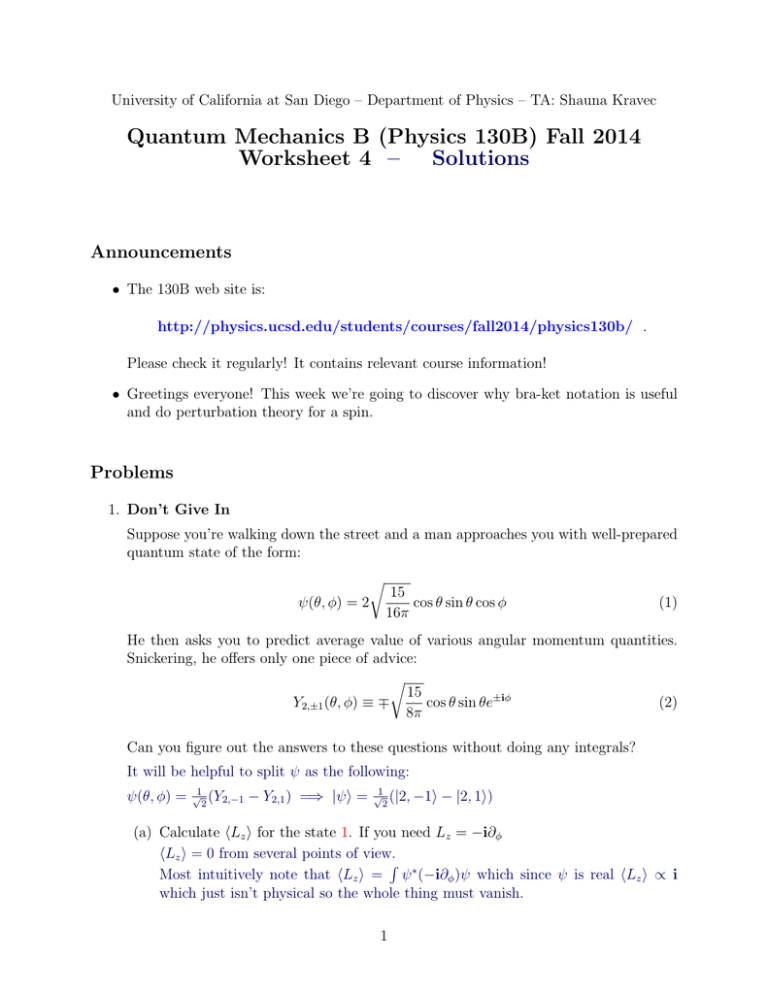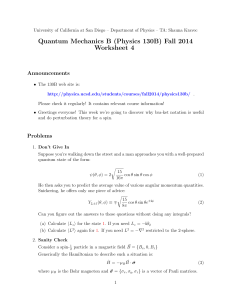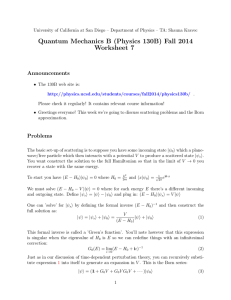Quantum Mechanics B (Physics 130B) Fall 2014 Worksheet 4 – Solutions
advertisement

University of California at San Diego – Department of Physics – TA: Shauna Kravec
Quantum Mechanics B (Physics 130B) Fall 2014
Worksheet 4 –
Solutions
Announcements
• The 130B web site is:
http://physics.ucsd.edu/students/courses/fall2014/physics130b/ .
Please check it regularly! It contains relevant course information!
• Greetings everyone! This week we’re going to discover why bra-ket notation is useful
and do perturbation theory for a spin.
Problems
1. Don’t Give In
Suppose you’re walking down the street and a man approaches you with well-prepared
quantum state of the form:
r
ψ(θ, φ) = 2
15
cos θ sin θ cos φ
16π
(1)
He then asks you to predict average value of various angular momentum quantities.
Snickering, he offers only one piece of advice:
r
15
Y2,±1 (θ, φ) ≡ ∓
cos θ sin θe±iφ
(2)
8π
Can you figure out the answers to these questions without doing any integrals?
It will be helpful to split ψ as the following:
ψ(θ, φ) =
√1 (Y2,−1
2
− Y2,1 ) =⇒ |ψi =
√1 (|2, −1i
2
− |2, 1i)
(a) Calculate hLz i for the state 1. If you need Lz = −i∂φ
hLz i = 0 from several points of view.
R
Most intuitively note that hLz i = ψ ∗ (−i∂φ )ψ which since ψ is real hLz i ∝ i
which just isn’t physical so the whole thing must vanish.
1
We can also do an explicit check with the form of |ψi using Lz |`, mi = m|`, mi
hLz i = hψ|Lz |ψi = 21 (h2, −1| − h2, 1|)(−|2, 1i − |2, −1i) = 12 (1 − 1) = 0
where in the above I’ve used orthogonality. You could also do the integral but I
wouldn’t.
(b) Calculate hL2 i again for 1. If you need L2 = −∇2 restricted to the 2-sphere.
Here it’s easiest to use the form of |ψi and the fact L2 |`, mi = `(` + 1)|`, mi
hL2 i = 21 (h2, −1| − h2, 1|)(−2(2 + 1)|2, 1i + 2(2 + 1)|2, −1i = 21 (6 + 6) = 6
You can also do the integral. I’ve attached a Mathematica notebook where this
is done and confirms my result.
2. Sanity Check
~ = {Bx , 0, Bz }
Consider a spin- 12 particle in a magnetic field B
Generically the Hamiltonian to describe such a situation is:
~ ·σ
~
Ĥ = −µB B
(3)
~ = {σx , σy , σz } is a vector of Pauli matrices.
where µB is the Bohr magneton and σ
(a) Suppose Bx = 0, find the eigenstates and energies associated with 3
E↑,↓ = ∓µB Bz and for {| ↑i, | ↓i} respectively
(b) Now suppose Bz Bx 6= 0 and compute the first and second order corrections
to the energy using perturbation theory.
(1)
E↑ = h↑ |(−µB Bx σx )| ↑i = 0 and similar for | ↓i where we use σx | ↑i = | ↓i
The second order shifts are more interesting:
P
2
2
(2)
µB Bx2
x |↑i|
x )|↑i|
= (µB Bx )2 |h↓|σ
E↑ = k6=↑ |hk|(−µ(0)B Bx σ(0)
(0)
(0) = − 2Bz
E↑ −Ek
(2)
E↓
E↑ −E↓
(2)
−E↑
and similarly
=
Putting it all together the energy up to second order is:
x 2
E↑,↓ = ∓µB Bz (1 + 12 ( B
))
Bz
(c) Now it turns out 3 is exactly solvable. Compute the energies of the exact eigenstates by direct diagonalization. Show by second order Taylor expansion this
agrees with the above.
q
p
Bz Bx
E↑ 0
x 2
Ĥ = −µB
=
where E↑,↓ = ∓µB Bx2 + Bz2 = ∓µB Bz 1 + ( B
)
Bz
Bx −Bz
0 E↓
√
The Taylor expansion of 1 + 2 ≈ 1 + 12 2 which validates the above.
2







